Coode Surname Ancestry ResultsOur indexes 1000-1999 include entries for the spelling 'coode'. In the period you have requested, we have the following 148 records (displaying 101 to 110): Single Surname Subscription | | | Buying all 148 results of this search individually would cost £752.00. But you can have free access to all 148 records for a year, to view, to save and print, for £100. Save £652.00. More... |
These sample scans are from the original record. You will get scans of the full pages or articles where the surname you searched for has been found. Your web browser may prevent the sample windows from opening; in this case please change your browser settings to allow pop-up windows from this site. Estates of the Deceased
(1886)
Distribution of the assets of the deceased: giving the names of the deceased and trustees &c. England and WalesCOODE. Cost: £6.00.  | Sample scan, click to enlarge

| Boys entering Clifton College
(1887)
Clifton College near Bristol was established in 1862. This edition of the Clifton College Annals and Register for the Old Cliftonian Society by F. Borwick was published in 1925. Boys are listed alphabetically by term of entry, with full names, surname first, in bold. Father's (or widowed mother's) name is given (surname and initials) in capitals, and address. Then there is the name of the house (N. T., North Town; S. H., School House; S. T., South Town), first and last forms, distinctions in school work and games, and month of leaving. Where known, the editor then gave a career summary with month of death; or, if still living, address as in 1925 (in italics).COODE. Cost: £4.00.  | Sample scan, click to enlarge
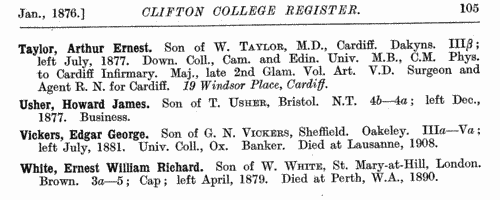
| Boys entering Haileybury College, Hertfordshire
(1887)
Haileybury College, near Hertford, was founded by the East India Company in 1806, and incorporated by Royal Charter in 1864. This register of pupils entering the school from 1862 to 1931 was edited by a master there, Laurence Arthur Speakman. The boys are listed by term of joining the school, and then alphabetically by name (in bold), surname first (in capitals). There is then usually a precise birthdate, and the name and address of his father; his period at the school, starting with abbreviations to indicate the house to which he belonged (B., Batten; B. F., Bartle Frere; C., Colvin; E., Edmonstone; Ha., Hailey; Hi., Highfield; L., Lawrence; Le B., Le Bas; M., Melvill; Th., Thomason; T., Trevelyan), and the first and last forms attended (e. g., IV., fourth form). Where a member of a school team there is then an indication (e. g., XI., cricket). For some pupils, with whom the school had lost touch, Speakman was only able to record the details of their time at Haileybury; but for most a brief career synopsis is then given, and current address (as in 1931) or date of death.
COODE. Cost: £4.00.  | Sample scan, click to enlarge
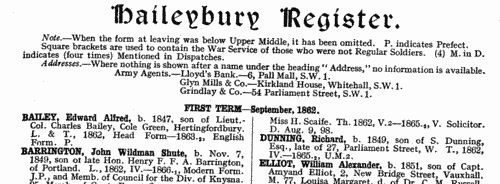
| Honorary Associates of the Royal Institute of British Architects
(1888)
The Kalendar of the Royal Institure of British Architects for 1888-9 includes this list of members, corrected to 8 November 1888. It is in six parts: Honorary Fellows, Fellows, Honorary Associates, Associates, and those nominated by ballot to become Fellows and Associates. The names throughout are given in full, surname first, with current address. Those members marked * had been previously Members of Council. Members of the present Council were printed in full capitals. Those marked with a dagger were in possession of a certificate of competency to act as a District Surveyor or a Building Surveyor; those with a double dagger had passed the institute's architecture examination. (L) indicates a life member. "Honorary Associates shall be persons, not following the profession of an Architect but interested in the study of Architecture, who by their connection with art or science are qualified to concur with Architects in the advancement of professional knowledge, and who are unconnected with any branch of building as a trade or business."COODE. Cost: £4.00.  | Sample scan, click to enlarge

| Boys entering Haileybury College, Hertfordshire
(1898)
Haileybury College, near Hertford, was founded by the East India Company in 1806, and incorporated by Royal Charter in 1864. This register of pupils entering the school from 1862 to 1931 was edited by a master there, Laurence Arthur Speakman. The boys are listed by term of joining the school, and then alphabetically by name (in bold), surname first (in capitals). There is then usually a precise birthdate, and the name and address of his father; his period at the school, starting with abbreviations to indicate the house to which he belonged (B., Batten; B. F., Bartle Frere; C., Colvin; E., Edmonstone; Ha., Hailey; Hi., Highfield; L., Lawrence; Le B., Le Bas; M., Melvill; Th., Thomason; T., Trevelyan), and the first and last forms attended (e. g., IV., fourth form). Where a member of a school team there is then an indication (e. g., XI., cricket). For some pupils, with whom the school had lost touch, Speakman was only able to record the details of their time at Haileybury; but for most a brief career synopsis is then given, and current address (as in 1931) or date of death.
COODE. Cost: £4.00.  | Sample scan, click to enlarge
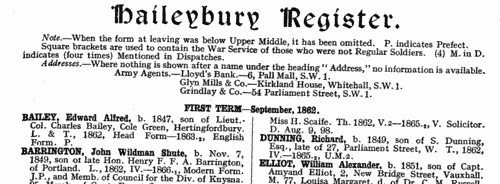
| Officers of the Royal Navy and the Royal Marines
(1898)
The Navy List, published by Authority, corrected to 18 December 1898, has this list of the officers on the Active List of the Royal Navy and the Royal Marines. Each officer's surname, christian name, and any middle initial(s) is given; with rank, date of seniority in that rank, and 'where serving', the last being the number of his ship. The ranks are: A, Admiral; A E, Assistant Engineer; A F, Admiral of the Fleet; A P, Assistant Paymaster; Art E, Artificer Engineer; As Ck, Assistant Clerk; B, Boatswain; Bandr, Bandmaster Royal Marines; C, Captain; Car, Carpenter; Ch, Chaplain; Ch B, Chief Boatswain; Ch Cr, Chief Carpenter; Ch E, Chief Engineer; Ch Gr, Chief Gunner; Ch P; Paymaster-in-Chief; Ck, Clerk; Cr, Commander; D I H, Deputy Inspector-General of Hospitals and Fleets; E, Engineer; E Ins, Inspector of Machinery; F E, Fleet Engineer; F P, Fleet Paymaster; F S, Fleet Surgeon; Gr, Gunner; H Sch, Head Schoolmaster; I H, Inspector-General of Hospitals and Fleets; L, Lieutenant; Mid, Midshipman; N C, Naval Cadet; N I, Naval Instructor; P, Paymaster; R A, Rear Admiral; S, Surgeon; S C, Staff-Captain; S Cr, Staff Commander; S E, Staff Engineer; S L, Sub-Lieutenant; S P, Staff Paymaster; S S, Staff Surgeon; Schm, Schoolmaster Royal Marines; St Ma, Sergeant Major Royal Marines; V A, Vice Admiral; W O, Warrant Officer Royal Marines. The column 'Where serving' also may have these abbreviations: AdC, Aide-de-Camp to the Queen; AO, Clerk to Secretary to a Flag Officer; CG, Coast Guard; CGP, Coast Guard Pension; DY, Dock Yard; GH, Greenwich Hospital; GHP, Greenwich Hospital Pension; GSP, Good Service Pension; NH, Naval Hospital; NID, Naval Intelligence Department; NP, Naval Pension (late Out-Pension of Greenwich Hospital); PW, Pension for Wounds; Sec, Secretary to a Flag Officer; TP, Travers Pension; TS, In the Transport Service; VY, Victualling Yard.
COODE. Cost: £6.00.  | Sample scan, click to enlarge
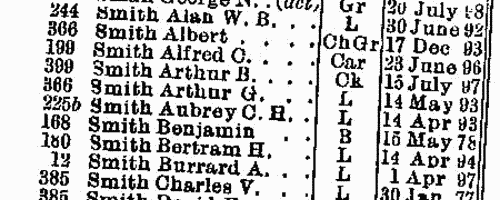
| Eton College boys and masters
(1900)
Printed lists of boys attending Eton College were issued each School-Time or term. This is the list for Michaelmas School-Time, 1900. The governors and masters of the schools are given first: then the names of a scholar elected for King's in December 1899, and the names and ages of 20 scholars elected for Eton in July 1900, 12 of whom had been admitted. Winners of the Newcastle Scholarship, two each year, back to 1829, and of the various college scholarships and prizes for 1899, precede the Distinctions in Trials (examinations) for July 1900. The First Hundred and Certificate examination list for Election 1900 list the boys in order of merit and with the marks awarded in Classics, Mathematics, Scripture Knowledge and History. The Certificate list is divided into First, Second and Third Classes, Passed, and Failed. The names of examiners and absentees are also given. Then follow the main lists of all the pupils, arranged by class. For every boy his position in class, surname, house tutor's name and classical tutor's name, are given; and evey boy's entry is annotated with details of his prizes during his whole period at the school. In the fifth forms the list for each class is divided into four parts, divided by a dotted line, then a wavy line, and then a full line. The top fourth had all obtained distinction in the last trials; those above the wavy line had been classed in the last trials; next were the unclassed; and below the full line were those boys who had failed in the trials.
COODE. Cost: £6.00.  | Sample scan, click to enlarge
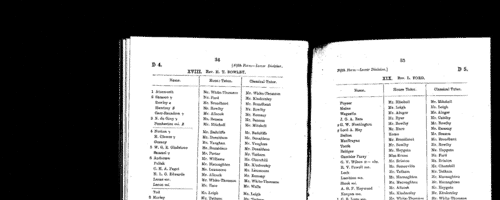
| Eton College boys and masters
(1900)
Printed lists of boys attending Eton College were issued each School-Time or term. This is the list for Midsummer School-Time, 1900. The governors and masters of the schools are given first: then the names of a scholar elected for King's in December 1899, and the names and ages of 16 scholars elected for Eton in July 1899, 15 of whom had been admitted. Winners of the Newcastle Scholarship, two each year, back to 1829, and of the various college scholarships and prizes for 1899 and 1900, precede the Distinctions in Trials (examinations) for March 1900. The First Hundred and Certificate examination list for Election 1899 list the boys in order of merit and with the marks awarded in Classics, Mathematics, Scripture Knowledge and History. The Certificate list is divided into First, Second and Third Classes, Passed, and Failed. The names of examiners and absentees are also given. Then follow the main lists of all the pupils, arranged by class. For every boy his position in class, surname, house tutor's name and classical tutor's name, are given; and evey boy's entry is annotated with details of his prizes during his whole period at the school. In the fifth forms the list for each class is divided into four parts, divided by a dotted line, then a wavy line, and then a full line. The top fourth had all obtained distinction in the last trials; those above the wavy line had been classed in the last trials; next were the unclassed; and below the full line were those boys who had failed in the trials.
COODE. Cost: £6.00.  | Sample scan, click to enlarge
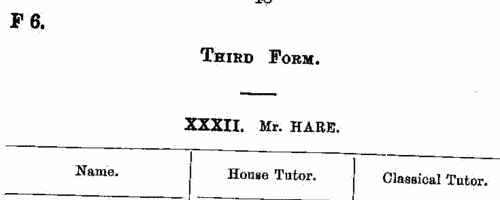
| Eton College boys and masters
(1900)
Printed lists of boys attending Eton College were issued each School-Time or term. This is the list for Lent School-Time, 1900. The governors and masters of the schools are given first: then the names of a scholar elected for King's in December 1899, and the names and ages of 16 scholars elected for Eton in July 1899, 12 of whom had been admitted. Winners of the Newcastle Scholarship, two each year, back to 1829 (here indexed from 1859 onwards), and of the various college scholarships and prizes for 1899, precede the Distinctions in Trials (examinations) for December 1899. The First Hundred and Certificate examination list for Election 1899 list the boys in order of merit and with the marks awarded in Classics, Mathematics, Scripture Knowledge and History. The Certificate list is divided into First, Second and Third Classes, Passed, and Failed. The names of examiners and absentees are also given. Then follow the main lists of all the pupils, arranged by class. For every boy his position in class, surname, house tutor's name and classical tutor's name, are given; and evey boy's entry is annotated with details of his prizes during his whole period at the school. In the fifth forms the list for each class is divided into four parts, divided by a dotted line, then a wavy line, and then a full line. The top fourth had all obtained distinction in the last trials; those above the wavy line had been classed in the last trials; next were the unclassed; and below the full line were those boys who had failed in the trials.
COODE. Cost: £6.00.  | Sample scan, click to enlarge
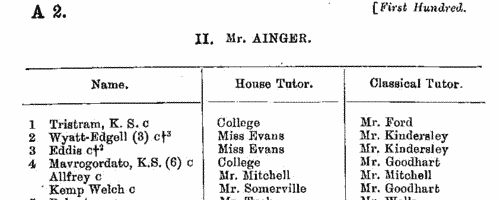
| Unclaimed Naval Prize Money
(1855-1902)
Various prize moneys were awarded to officers and men who served on board her Majesty's ships. For one reason or another a substantial number of these prizes, from as little as a shilling or two to as much as many pounds, remained undistributed by 1902, when this comprehensive list of the unclaimed moneys was printed: it lists unclaimed shares of prize money, slave and pirate bounties, salvage awards, parliamentary grants, gratuities and other moneys distributed by the Admiralty 1855 to 1902, but which omits moneys for service on the China Station during the war of 1856 to 1880, and special gratuities for service in Egypt (1882), Soudan (1884) and Soudan and Nile Expedition (1884-1885), for which there are separate indexes. In each case the sailor's name is given first (surname, then christian name or initials); rank or rating; ship in which serving at time of capture or award; and the amount due.COODE. Cost: £6.00.  | Sample scan, click to enlarge

|
Research your ancestry, family history, genealogy and one-name study by direct access to original records and archives indexed by surname.
|












